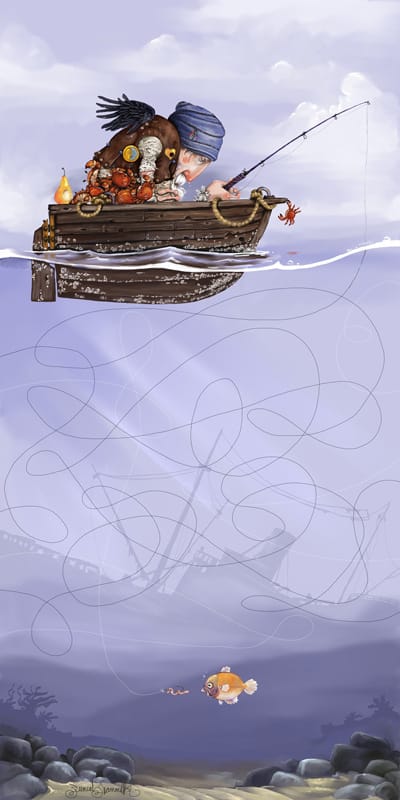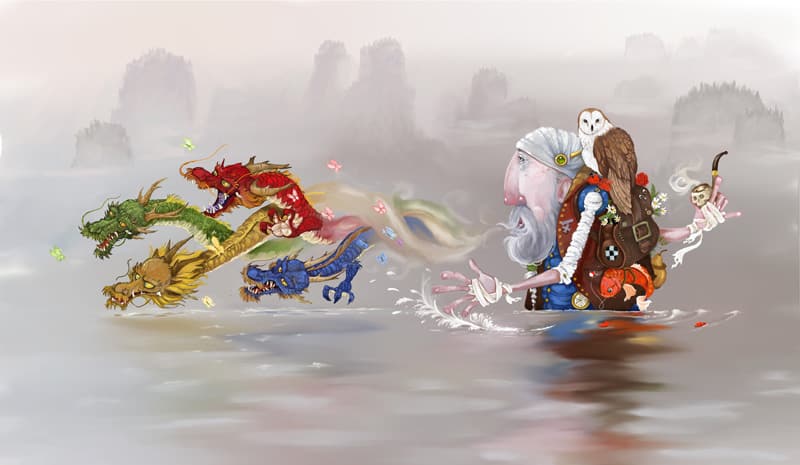My father is a great artist and as far back as I can remember, I wanted to be as good of an artist as he was. As a child I would draw frequently but my style didn’t really develop until High School where I was lucky enough to have an art teacher (Mrs. Sherwood) who allowed me to really do whatever I wanted and experiment in many different mediums. At that time, I was introduced to the Fantasy Art of James C Christensen, whose work inspires me to this day. I will never forget when my mom surprised me with a $50 James Christensen art book (that was a lot of money for us at the time) which I still have and flip through when I am looking for ideas/inspiration.

Currently I am working on a series of “how to” picture books with my wife Sandy. We are kicking the series off with Og and Pip’s Guide to Happy Hiking and the follow up Og and Pip’s Guide to Basic Beach Combing. These intend to be a fun guide for kids to learn about safety and conservation with a backdrop of beautiful Pacific Northwest parks which are vibrant landscapes that are always fun to paint.
I always have projects I am developing or playing with – usually children’s books or fantasy paintings.
I don’t know if I can just name one! I have had the privilege to work with an amazing local Seattle book publisher Sasquatch Books since the start of my illustration career (almost 20 years now). Every project that I have worked on with them has been an absolute pleasure. The one project that might stand out is Little Red Riding Hood – of the Pacific Northwest. This was my first attempt to use a digital medium for my illustration. Needless to say, I learned so much about digital illustration by the end of the project and have been using Corel Painter ever since.
Pretty standard middle age dad stuff! LOL… I have two 12-year-old boys (Wolfgang and River) that keep me on my toes. But as far as art projects go – every day is different and depending on the project, every approach is different. For the most part at the start of a project, my days are filled with looking through books (or websites) to get inspiration and come up with some ideas. Then I draw a lot – I take a piece of bristle board and fill the whole page with different scribbles and ideas. If I am working on a book project I will do rough page layouts to plan the flow of the book. This can take hours or days. From there I refine the ideas into a detailed drawing – transfer the drawings to canvas or digital screen – and start painting (this can take days, weeks or months!) It is always hard for me to say I am done with a project – and send it off. Usually project milestones force me to say that I have done all I can and its ready to send. With digital paintings I find myself coming back to works that I thought were completed – and continue to refine and or add on to. Especially some of my first digital art paintings – If I discovered a new brush or technique I find myself pulling up old paintings and working on them again. It never ends!
Painter allows you to explore new techniques, experiment with new mediums and play with new brushes. Endless opportunities here. Every time I use Painter I learn something and grow as an artist – this is so much fun for me. There is so much to explore with Painter – I have barely scratched the surface of what it can do.

My go to brushes continue to be the Oil Pastel, Oil Flat, Just Add Water Blender and Oil Blender. That combination gives me the look and versatility that works very well for me.
For me, my art career is not a full time gig. I am also a full-fledged coffee guru who is very proud to be an Assistant Director at the University of Washington where I oversee Coffee Roasting and Education Programs as well as UW’s District Market Stores. The challenges associated with being a part time artist is quite simply – finding the time. If anything good came out of COVID it forced us to have more time, time that could be used for art projects. Art is a great way to keep busy in isolation or while being socially distant. For myself – that is what allowed me the time to respond to Corel’s Call for Entries for their first annual art competition. That is when I submitted “leap of faith” which in turn created the opportunity to talk with you today.
After 20 years, I still see myself as an up-and-coming artist, but as I reflect on my earlier years and if I were to give any advice, it would be to be open to feedback. When you love what you do, it can be difficult at times to receive criticism/feedback. Working with clients and art directors should be a collaboration. And I can say the best published works that I have created is when I have been the most open to Art Directors feedback and in turn them being open to mine. In publishing, the projects that had strong collaborations always end up being the top sellers. The better the communication, the more fun the projects become and the better the result will be.
My Illustration career got kick started by simply drawing on a menu at a local coffee shop in Anchorage Alaska where I was working as a Barista (it was to promote a Screaming Monkey Latte). That caught the eye of the Art Director of Alaska Magazine (Linda Lockhart) – My work for Alaska Magazine caught the eye of the Art Director of Sasquatch Books (Kate Rogers). My point here is to just get your work out there. If you love making art – DO IT and get your work in front of as many people as possible. This is a lot easier to do in 2021 than it was in 1998, take advantage of technology and social media. Continue to do what you love and you will get noticed. In my experience, if you love what you do, that love will come through in the art that you create and in turn, get you noticed by clients.